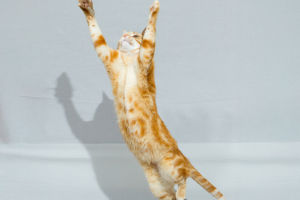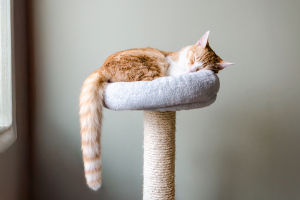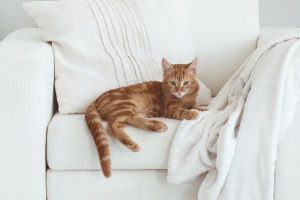If you've ever watched your cat flick its tail or crouch in a certain position, you might have wondered what exactly it's trying to communicate.
Unlike humans, who rely on spoken language to express emotions, cats use their bodies to send messages.
From the twitch of an ear to the way their tail sways, every little movement has a meaning. Understanding these signals can not only improve your relationship with your feline companion but also help you better meet its needs.
The Tail: A Window to Their Emotions
One of the most expressive parts of a cat's body is its tail. Cats use their tails to communicate a wide range of feelings, from happiness to agitation, making it one of the most important tools in their emotional vocabulary.
A Straight Up Tail: When your cat approaches you with its tail held high, it's typically a sign of confidence and friendliness. A raised tail indicates that the cat feels comfortable and safe in its environment. This is the equivalent of a cat saying, "I trust you" or "I'm happy to see you."
Flicking or Twitching Tail: If your cat's tail is flicking or twitching rapidly, it often means that your cat is feeling annoyed or frustrated. This can happen when they're overstimulated, such as during a play session or when they're being petted for too long. Pay attention to other signs of discomfort, such as ears flattening or a stiff posture, which may indicate that the cat needs some space.
Low or Tucked Tail: A tail held low or tucked between the legs signals fear, anxiety, or submission. If your cat suddenly drops its tail when meeting a new person or encountering a loud noise, it's trying to make itself appear smaller in the face of danger. This is a clear indicator that your cat is uncomfortable or scared.
The Ears: Subtle but Telling
Cats' ears are incredibly sensitive, and their position can tell you a lot about their emotional state. While humans might not always notice the subtle shifts, a cat's ears are like tiny antennae picking up on the world around them.
Upright Ears: When your cat's ears are upright and facing forward, it's alert, curious, and focused. This is the body language equivalent of a human who is engaged in a conversation. Your cat might display this posture when it's watching something interesting, like a bird outside the window or a toy you're holding.
Flattened Ears: If your cat's ears are pressed flat against its head, it's a clear sign of distress, fear, or aggression. This is the feline equivalent of a human scowling or frowning. It may occur when a cat is startled, upset, or feeling threatened. If the ears are flattened and the cat is also hissing or growling, be cautious—your cat may be ready to defend itself.
Sideways Ears: When the ears are tilted to the side, your cat may be confused or uncertain. This behavior can happen when your cat is trying to figure out a situation or a new person. It's a sign of curiosity but also hesitation. If the ears shift back and forth, it indicates that the cat is unsure about its surroundings.
Posture: More Than Just Sitting Pretty
The way a cat carries itself tells you a lot about how it's feeling in the moment. From its body position to its overall stance, cats express their emotions through posture more than we realize.
Relaxed Body: When your cat is lying on its side or belly-up with all fours tucked in comfortably, it's in a relaxed, trusting state. This is a vulnerable position, as the cat is exposing its stomach, which it would usually protect in a more defensive posture. If your cat falls asleep like this, it's showing you that it feels completely safe in its environment.
Crouching and Hunched: A cat that is crouching or has its body hunched low to the ground is likely feeling threatened or is preparing to pounce. This posture is common when a cat is in "hunt" mode, but it can also be an indicator of fear or anxiety. If the cat's tail is flicking while in this position, it may be getting ready to pounce or react aggressively.
Arched Back: If your cat arches its back, especially if it's accompanied by puffed-up fur, it's attempting to make itself appear larger in response to perceived danger. This is often seen when a cat feels threatened or cornered. If combined with hissing or growling, this is a sign that your cat feels cornered and is preparing to defend itself.
Other Key Cat Body Language Signals
Aside from the tail, ears, and posture, there are a few other subtle ways that cats communicate their feelings. These non-verbal cues are often overlooked but can be just as telling.
Slow Blinking: One of the most affectionate gestures a cat can make is a slow blink. If your cat looks at you and slowly closes its eyes, it's a sign of trust and affection. This is similar to a human smiling or showing contentment. If you slow blink back at your cat, it may strengthen the bond between you two.
Purring: While purring is often associated with contentment, it can also signal anxiety or pain, especially if your cat is purring in an unusual situation (such as when it's hiding or after a stressful event). Listen to the context of the purring. A calm, rhythmic purr often indicates that your cat is happy, while an anxious or irregular purr may mean something is wrong.
Scratching: Scratching isn't just a cat's way of keeping its claws sharp; it's also a form of marking territory. If your cat scratches furniture or objects, it may be leaving behind its scent to establish its space. While it may seem destructive, it's actually a way for your cat to communicate ownership and security.
Conclusion: The Silent Language of Cats
Your cat's body language is rich with meaning, and learning to interpret it can deepen your connection with your feline companion. By paying attention to the subtle movements of the tail, ears, and body, you can better understand your cat's emotional state and respond in a way that ensures it feels safe, loved, and understood.
Cats may not speak in words, but they communicate loudly and clearly through their body language. Whether your cat is happily curling up beside you, flicking its tail in frustration, or arching its back in defense, each gesture is an opportunity to understand its feelings. By decoding these signals, you'll be able to create a more harmonious environment and strengthen the bond between you and your cat.
So, next time your cat flicks its tail or gives you a slow blink, remember—it's trying to tell you something. And now, you're ready to listen.


